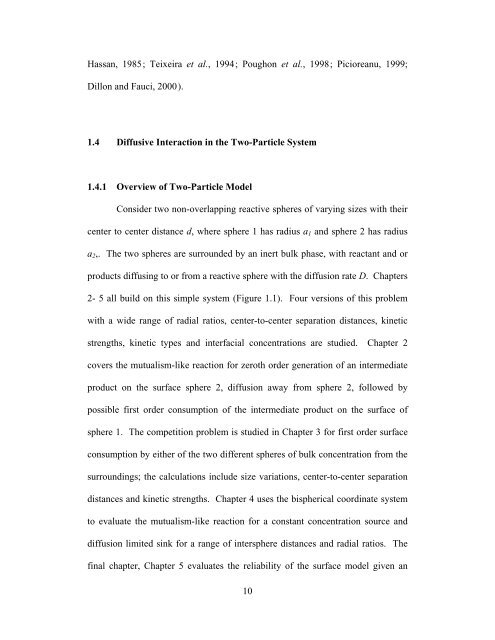Diffusion Reaction Interaction for a Pair of Spheres - ETD ...
Diffusion Reaction Interaction for a Pair of Spheres - ETD ...
Diffusion Reaction Interaction for a Pair of Spheres - ETD ...
Create successful ePaper yourself
Turn your PDF publications into a flip-book with our unique Google optimized e-Paper software.
Hassan, 1985; Teixeira et al., 1994; Poughon et al., 1998; Picioreanu, 1999;<br />
Dillon and Fauci, 2000).<br />
1.4 Diffusive <strong>Interaction</strong> in the Two-Particle System<br />
1.4.1 Overview <strong>of</strong> Two-Particle Model<br />
Consider two non-overlapping reactive spheres <strong>of</strong> varying sizes with their<br />
center to center distance d, where sphere 1 has radius a1 and sphere 2 has radius<br />
a2,. The two spheres are surrounded by an inert bulk phase, with reactant and or<br />
products diffusing to or from a reactive sphere with the diffusion rate D. Chapters<br />
2- 5 all build on this simple system (Figure 1.1). Four versions <strong>of</strong> this problem<br />
with a wide range <strong>of</strong> radial ratios, center-to-center separation distances, kinetic<br />
strengths, kinetic types and interfacial concentrations are studied. Chapter 2<br />
covers the mutualism-like reaction <strong>for</strong> zeroth order generation <strong>of</strong> an intermediate<br />
product on the surface sphere 2, diffusion away from sphere 2, followed by<br />
possible first order consumption <strong>of</strong> the intermediate product on the surface <strong>of</strong><br />
sphere 1. The competition problem is studied in Chapter 3 <strong>for</strong> first order surface<br />
consumption by either <strong>of</strong> the two different spheres <strong>of</strong> bulk concentration from the<br />
surroundings; the calculations include size variations, center-to-center separation<br />
distances and kinetic strengths. Chapter 4 uses the bispherical coordinate system<br />
to evaluate the mutualism-like reaction <strong>for</strong> a constant concentration source and<br />
diffusion limited sink <strong>for</strong> a range <strong>of</strong> intersphere distances and radial ratios. The<br />
final chapter, Chapter 5 evaluates the reliability <strong>of</strong> the surface model given an<br />
10
















